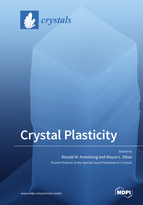Crystal Plasticity at Micro- and Nano-scale Dimensions
A special issue of Crystals (ISSN 2073-4352). This special issue belongs to the section "Inorganic Crystalline Materials".
Deadline for manuscript submissions: closed (15 November 2020) | Viewed by 62781
Special Issue Editors
Interests: dislocation mechanics; constitutive equations; Hall–Petch relations; Zerilli–Armstrong equations; microstructural stereology; high rate metal deformations; ductile-brittle transition behaviors; X-ray diffraction imaging
Special Issues, Collections and Topics in MDPI journals
Interests: mechanical properties; indentation hardness; microstructural characterization; historical ferrous metallurgy
Special Issues, Collections and Topics in MDPI journals
Special Issue Information
Dear Colleagues,
The advent of “nanotechnology” in the 1980s is often credited to the foresight expressed in one of Nobel Prize winner Richard Feynman’s lectures in late 1959, “There’s Plenty of Room at the Bottom”. The lecture featured the potential advantages in chemistry to be gained by the manipulation of atoms on an atomic scale, and that nano-scale mechanical devices would be designed and developed in future engineering applications. The lecture presaged the Nobel Prize winning developments of atomic force microscopy and scanning tunneling microscopy. An important industrial impetus was provided by the development of micro-electro-mechanical system (MEMS) devices, and also later by developments of both nano-scale testing systems, such as nano-indentation hardness testing, and micro-scale specimen fabrication methods, such as the focused ion beam (FIB) manufacturing of micro-pillars and the production of nano-particles and nano-wires. Instead, less attention has been given to enabling the order-of-magnitude strength advantage provided in nano-scale crystal dimensions and within nano-polycrystalline microstructures, both of which are topics included in the present Crystals journal’s Special Issue. Such an achievement in the strength levels has coincided with other recent advancements in the crystal dislocation mechanics theories accounting for such crystal deformation properties. The advanced testing methods and related model simulations of the crystal properties provide an opportunity for quantitatively accounting for the character of the individual dislocations or their interactions within small groups. The aim of the present Special Issue is to provide a welcome venue for contributed works on this rapidly developing subject.
Prof. Ronald W. Armstrong
Prof. Wayne Elban
Guest Editors
Manuscript Submission Information
Manuscripts should be submitted online at www.mdpi.com by registering and logging in to this website. Once you are registered, click here to go to the submission form. Manuscripts can be submitted until the deadline. All submissions that pass pre-check are peer-reviewed. Accepted papers will be published continuously in the journal (as soon as accepted) and will be listed together on the special issue website. Research articles, review articles as well as short communications are invited. For planned papers, a title and short abstract (about 100 words) can be sent to the Editorial Office for announcement on this website.
Submitted manuscripts should not have been published previously, nor be under consideration for publication elsewhere (except conference proceedings papers). All manuscripts are thoroughly refereed through a single-blind peer-review process. A guide for authors and other relevant information for submission of manuscripts is available on the Instructions for Authors page. Crystals is an international peer-reviewed open access monthly journal published by MDPI.
Please visit the Instructions for Authors page before submitting a manuscript. The Article Processing Charge (APC) for publication in this open access journal is 2600 CHF (Swiss Francs). Submitted papers should be well formatted and use good English. Authors may use MDPI's English editing service prior to publication or during author revisions.
Keywords
- micro-crystals
- nano-crystals
- strength
- plasticity
- dislocations
- simulations







